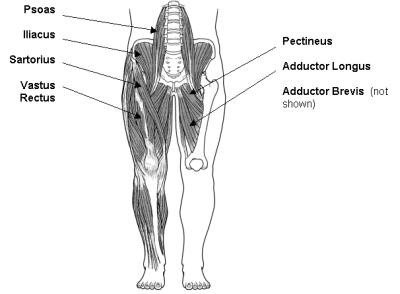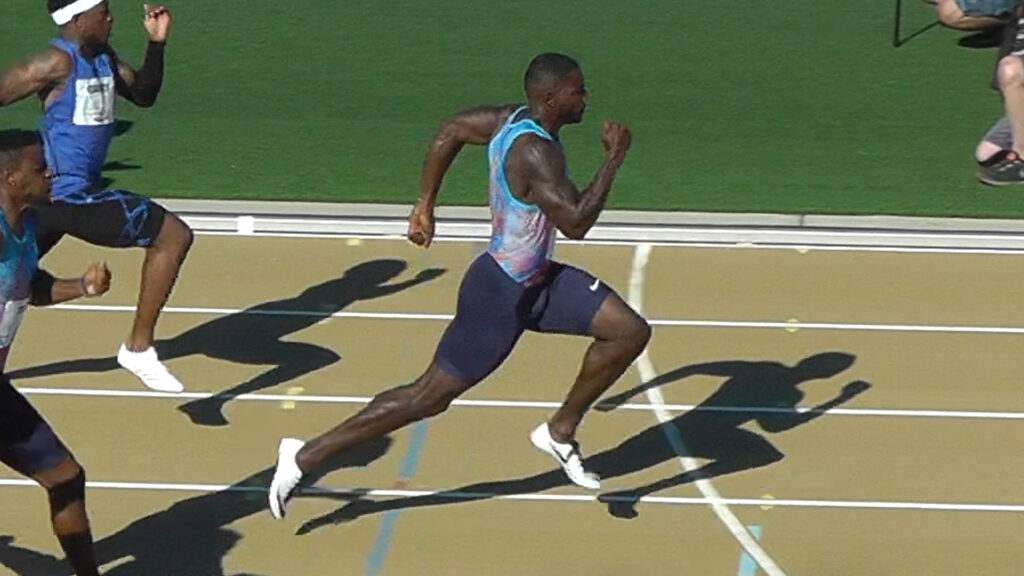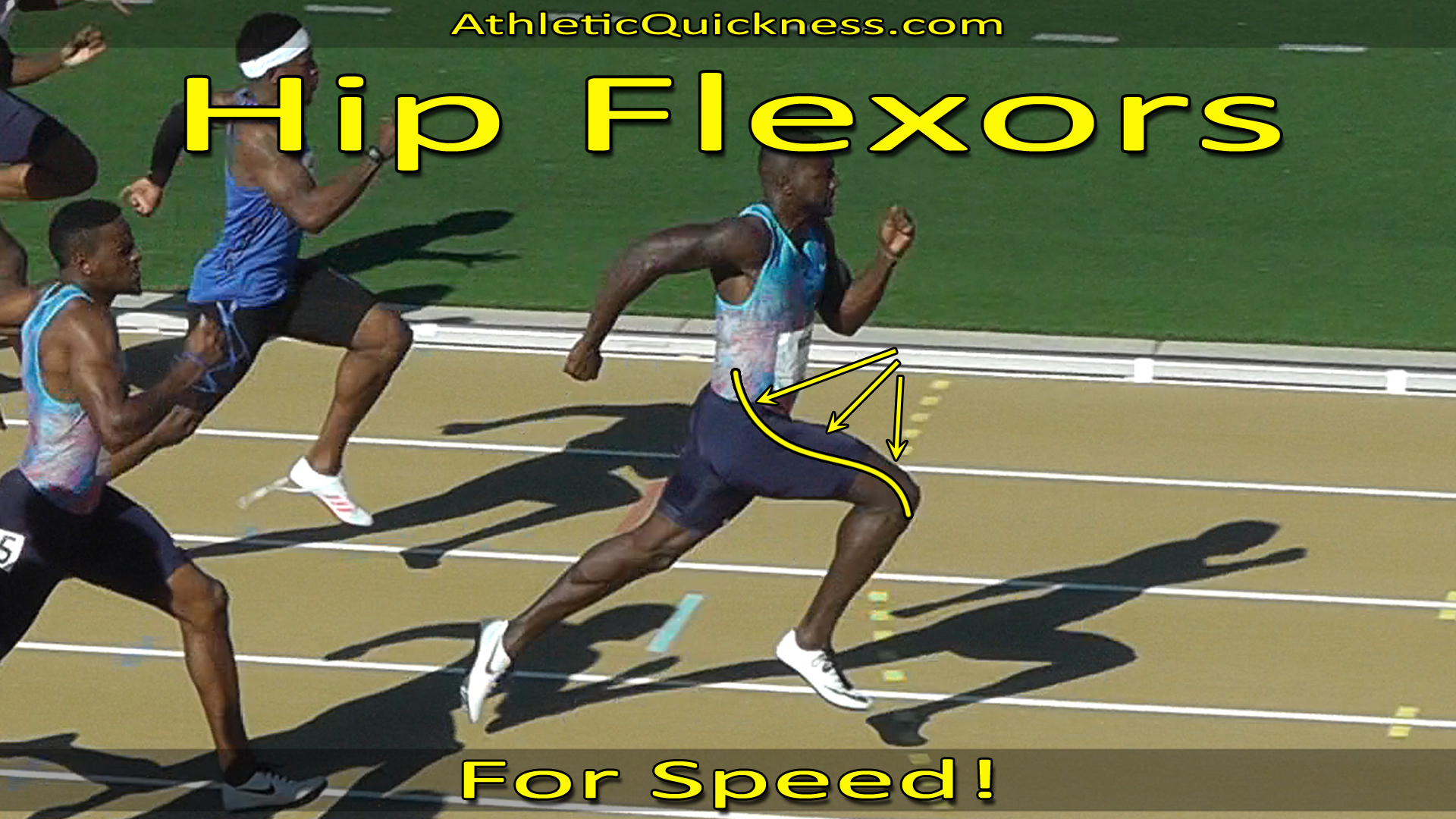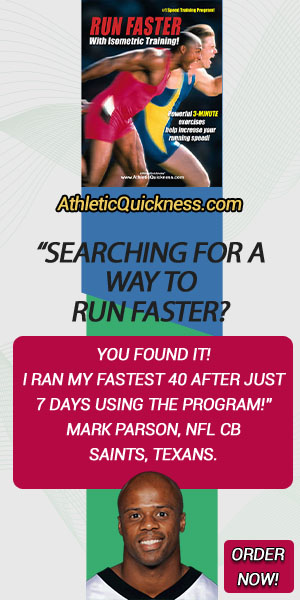Any athlete who wants to run faster will certainly want to train their hip flexors for speed. One reason is because they are the longest and largest muscle group in the body, comprising of seven different muscles on each side of the body and they drive the acceleration phase of sprinting like no other group. The names of these muscles are: 1) Psoas, 2) Iliacus, 3) Sartorius, 4) Vastus Rectus (a.k.a Rectus Femoris), 5) Adductor Longus, 6) Adductor Brevis, and 7) Pectineus and be seen in Figure 1 below:

Figure 1. The Hip Flexor Muscles.
The hip flexors are also known as thigh flexors and the reason we sometimes like to call these muscles this is because it is much easier for people to visualize the movement of their thighs at the hip joint, rather than trying to figure out what is going on deep within the hip joint itself.
Function of the Hip Flexors
As their name implies, the function of the hip flexor muscles is to flex the hip, or thigh, upward, at the hip joint. This can be seen by looking at the athlete’s left thigh in Figure 2 below.

Figure 2. Hip Flexors in Action
This upward thrusting of the thigh at the hip joint helps to drive the body forward, enabling the athlete to run with faster speed.
The fulcrum or leverage point of this hip flexor motion takes place inside the hip joint where the head of the femur mates into the acetabulum. The acetabulum is a rather complex joint when compared to other joints in the body. It is formed by the union of three separate bones: 1) ischium, 2) ilium, and 3) pubis. All three of these bones form a cup-shaped cavity, or socket, in which the ball-shaped head of the femur moves.
How to Exercise the Hip Flexors for Speed
For many, the exercise of choice for these muscles is your basic sit-up and/or hanging knee raise exercise. However, both of these exercises will only target two of the seven hip flexor muscles listed above in Figure 1 and those are the psoas and iliacus muscles.
The other five hip flexor muscles require a little more creativity to target and as a result, even when athletes think they are training their hip flexors for speed and quickness, they are almost always leaving the other five out of the picture.
Again, the one’s that typically go untrained are the Sartorius, rectus femoris, adductor brevis, adductor longus and pectineus. These five muscles need special attention if you ever hope to tap into the full benefit of the hip flexor muscles.
Unfortunately, you can’t target these muscles safely or directly on a machine, so don’t look for one, they don’t exist in the gym. This further leads athletes to believe that if they simply use all of the equipment at their disposal, that somehow, some way, they will have done everything they could to improve their athletic performance.
While this may work for some muscle groups, it will not work for the hip flexors. So as a quick test for you to determine if this is the case, can you name one exercise that you might be doing right now where you are physically raising your knee upward, under resistance while at the same time you are placing significant leverage on any one of these five remaining hip flexor muscles? There aren’t many choices and as a result, the entire thigh flexor muscle group goes untrained by athletes on every level.
How to Run Faster Exercise Program
Fortunately, that is what we here at AthleticQuickness.com do best! We provide sport specific training programs designed to attack an athlete’s weaker areas. We do this using the resistance band with an isometric training strategy and that allows us to create an entirely new set of exercises.
These exercises, when athletes try them for the first time, deliver impressive results. If you are looking to run faster, kick farther and jump higher to name a few, then you will definitely want to consider getting your copy of one or more of these training programs found here on this site. And, in case you are wondering, our programs are top notch at training the hip flexors for speed!
Innervation, or, Nerve Supply to the Hip Flexor Muscles
The nerve supply to the hip flexor muscles is as follows: The psoas muscle receives it’s nerve supply from the anterior branches of the lumbar plexus (L1, L2, L3, L4, & L5); The iliacus, sartorius, and vastus rectus receive their nerve supply from the femoral nerve (L2, L3, & L4 – a.k.a. anterior crural nerve). The pectineus, adductor longus and adductor brevis receive their nerve supply from the obturator nerve (L3,L4). The pectineus also receives additional nerve supply from the femoral nerve and the accessory obturator nerve. See Table 1 and Figure 3 below:
Table 1. Thigh Flexor Muscles and Their Nerve Supply.


Figure 3.
Antagonist Muscles of the Hip Flexors
The muscles that work in opposition to the hip flexors are the hip extensors. These muscles include your gluteal muscles and hamstrings.






